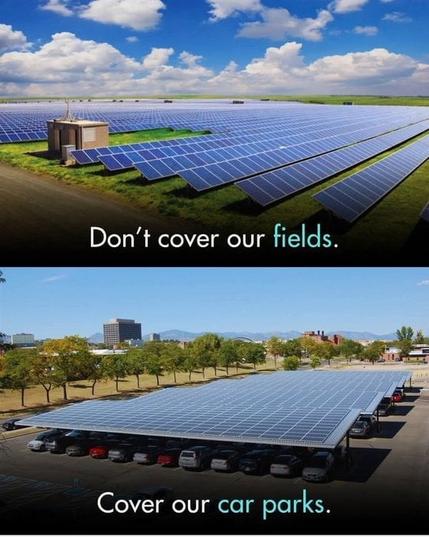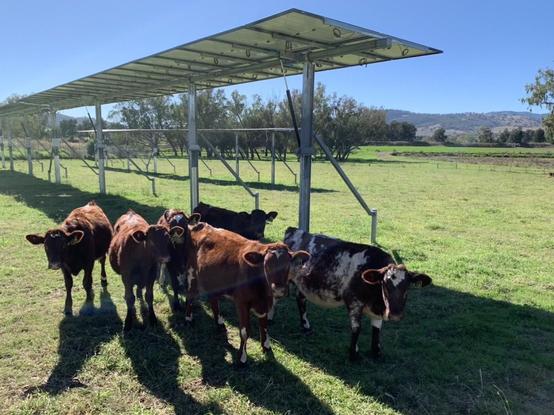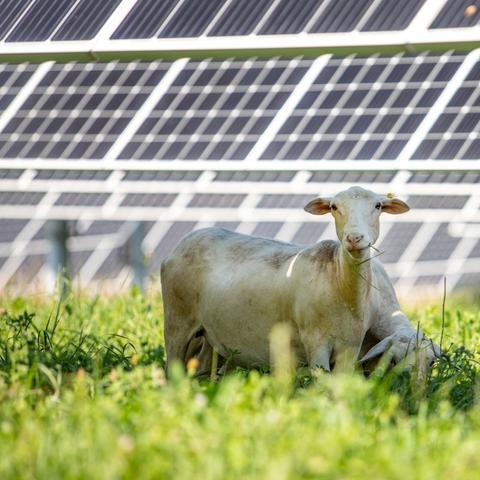🙌
🙌
@WiteWulf I like me grass! Also animals and such
@stux you can happily graze cattle under solar farms, we see it a lot around here (Leicestershire, UK).
@ariaflame @titia @M0YNG @WiteWulf @stux but not goats.
Apparently trials prove the obvious that they climb on the panels and break them
@roastinghouse @titia @M0YNG @WiteWulf @stux Yes, I heard that about goats too. Or kick them if they're the vertical ones.
@roastinghouse I'm sure breakthroughs will eventually be made in goatovoltaics 😌
@ariaflame @titia @M0YNG @WiteWulf @stux
@ariaflame @titia @M0YNG @WiteWulf @stux
@Tattie @roastinghouse @ariaflame @titia @M0YNG @stux flexible elastic PV panels: solar trampolines for goats
You know it makes sense 😆
This is apparently true.
I've also read (no reference) that wool yields from sheep grazed underneath went up?
@bytebro @M0YNG @WiteWulf @stux It's worth pointing out that a great many fields are artificial carveouts from other sorts of biome, like forest or grassland. In some cases, building elevated solar panels returns a measure of shade that was lost when farmers clearcut the area.
But yes, by all means, but them over car parks, too.
@bytebro Yep, source for the improved quality wool is https://lightsourcebp.com/nz/news/wool-quality-and-sustainability-insights-from-lightsource-bps-wellington-solar-farm/
(Source is an interested party but still, it does seem plausible that sheep who can hang out under shelter when they want will be less stressed than those exposed constantly to the elements.)
Agrivoltaics seems to be a win for the plants, for the animals, and for the panel efficiency and output.
As for the carparks, how about we get proper public transport, then we can turn most of the carpark into parklands (while leaving just enough space for accessibility and deliveries and emergencies) and that will also be a win for everyone. ;-)
@Beedazzled @stux no, they’re about 3ft tall, same as most sheep 😀
@WiteWulf @stux Here in Germany more and more vinyards are using Solarpanels to shade the vines. Traditionally, vines were planted in Germany on mountain slopes, because there was a lack of sun and warmth. With increasing temperatures due to climate change, it's getting warmer and warmer, and the vines need shade.
@WiteWulf @stux This article from "Spektrum der Wissenschaft" explains quite a lot regarding the synergy and problems of growing both crops and energy. Unfortunately, its behind a paywall and in German.
https://www.spektrum.de/news/energiewende-solarzellen-ueber-dem-acker/2274715
@stux @WiteWulf I was reading recently that since solar fields don't have any specific requirements around grazing or nitrogen fixation, they've started planting wildflowers and brushes, which are massively beneficial for insect populations and downstream ecosystems like birds. they described grass fields as a graveyard by comparison.
@gsuberland @stux @WiteWulf also the car park thing in lower quantity wouldn't be bad on fields with animals, either. You wouldn't know it from most of the farmland in the Netherlands, but livestock do actually need shade.
@len @gsuberland @WiteWulf @stux Elsewhere in the replies are two stories that mention using them in a barred pattern for sheep and for goats in conjunction with beehives. But absolutely any animals would be happier with intermittent shade and the lush graze that tends to bring than with a totally open, unshaded field - people in Europe and North America don’t realize how rare that once was and would be again without human intervention in most of the places they live and farm!
@cwicseolfor @len @gsuberland @WiteWulf @stux honey bees hate electrical equipment. Thats how you collect venom, getting them to try to sting electric wires
@Beedazzled @cwicseolfor @len @gsuberland @WiteWulf @stux That’s an interesting point. I would guess they don’t like magnetic fields, if so then solar panels being dc (until you get to the inverter) there shouldn’t be any. Probably worth testing if bees object to a static charge such as a battery?
@BashStKid @Beedazzled This sounds plausible to me also, based on my experience with our (invasive non-native) fire ants and electrical equipment. It's definitely good to consider the impact of additional intrusions on other species, but since beekeeping under agrivoltaics is already working (in so, SO many places) there must be a reason why! It'd also be worth finding out whether it's disruptive to other native insects and not just our "pet" honeybee species.
@len @gsuberland @WiteWulf @stux
@len @gsuberland @WiteWulf @stux
@BashStKid @cwicseolfor @len @gsuberland @WiteWulf @stux there is research showing overhead powerline affect navigation.
I carry my phone in a breast pocket and, if they are feeling ratty, they go mad trying to sting it
I carry my phone in a breast pocket and, if they are feeling ratty, they go mad trying to sting it
@Beedazzled Powerlines are "loud" given sheer voltage, but they aren't known for massing on them that I know of, so the DC vs. AC theory (and then of course all the other types of radio noise machinery can make) may have legs.
Shy of a dozen links, I found an article listing projects all over EU and North America - https://fresh-energy.org/solar-beekeeping-goes-global
Maybe you even know someone connected to one of the UK projects who'd know more, e.g. via any forums you're in?
@BashStKid @len @gsuberland @WiteWulf @stux
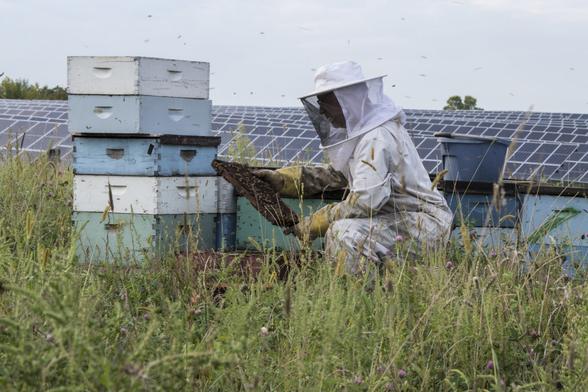
Global buzz for solar with pollinators and beekeeping - Fresh Energy
Dual-use solar is buzzing across the globe. Thanks to the education and outreach work of groups around the world—including the Center for Pollinators in Energy at Fresh Energy—global energy companies are actively moving forward with plans to combine solar energy with additional land uses and community benefits.
@cwicseolfor @BashStKid @len @gsuberland @WiteWulf @stux the only person I know with an apiary beside PV instalation is us, but we are beside it not under it and its not huge. The apiary was there first then the PV appeared
@cwicseolfor @BashStKid @len @gsuberland @WiteWulf @stux
https://www.newscientist.com/article/2373396-electromagnetic-fields-from-power-lines-are-messing-with-honeybees/#:~:text=A%20growing%20body%20of%20research%20has%20already,enough%20foragers%20to%20survive%20in%20some%20cases.&text=%E2%80%9CThe%20bees%20were%20avoiding%20the%20flowers%20that,proximity%20of%20the%20overhead%20lines%2C%E2%80%9D%20says%20Ballesteros.
https://www.newscientist.com/article/2373396-electromagnetic-fields-from-power-lines-are-messing-with-honeybees/#:~:text=A%20growing%20body%20of%20research%20has%20already,enough%20foragers%20to%20survive%20in%20some%20cases.&text=%E2%80%9CThe%20bees%20were%20avoiding%20the%20flowers%20that,proximity%20of%20the%20overhead%20lines%2C%E2%80%9D%20says%20Ballesteros.
@Beedazzled @BashStKid @cwicseolfor @len @gsuberland @stux interesting, our hives at work are near to a huge industrial testing facility for jet engines, and they’re known for being really angry all the time. I wonder if that’s to do with EM radiation? The estates staff who look after them swear at them 😀
@Beedazzled @cwicseolfor @len @gsuberland @WiteWulf @stux Overhead lines are probably the highest electrical field gradient most people ever come across. I can believe that an ac 275-400 kV would annoy something sensitive.
That’s a far cry from the low-voltage dc in panels, but the best thing is to do some experiments to be sure any correlation is definitely what you think it is. It’s depressingly easy to be convinced by your own theory.
That’s a far cry from the low-voltage dc in panels, but the best thing is to do some experiments to be sure any correlation is definitely what you think it is. It’s depressingly easy to be convinced by your own theory.
@BashStKid @cwicseolfor @len @gsuberland @WiteWulf @stux
I know 100% that bees don't like mobile phones or thunderstorms. As to pv, i would say its something to be looked into. I don't have a theory, I have a concern
I know 100% that bees don't like mobile phones or thunderstorms. As to pv, i would say its something to be looked into. I don't have a theory, I have a concern
But is the farmer making enough money to live on with those grass and animals?
Reliant on variable (and increasing extreme) weather, market prices, export prices, tarrifs etc.
It might look pretty, but it might not be economical worthwhile.
Using part of his land for solar lets the farmer have an guaranteed income through droughts etc.
You can also grow some crops better under solar. Sheep who graze under solar prduce better wool.
@WiteWulf
Also, roads, railways, other public infrastructure...
@NaN @mdione @stux If it’s at the edges, then we could put real trees there, providing wind breaks while sequestering carbon, sheltering animals and beneficial insects, all while looking nice; the upside of panels out in a field - not blanketed, but barred, as you can see in many replies to the original post - is that it shades the field underneath enough to increase the health of what’s growing under it but still allows people or even harvesting equipment underneath.
Switzerland is trying.
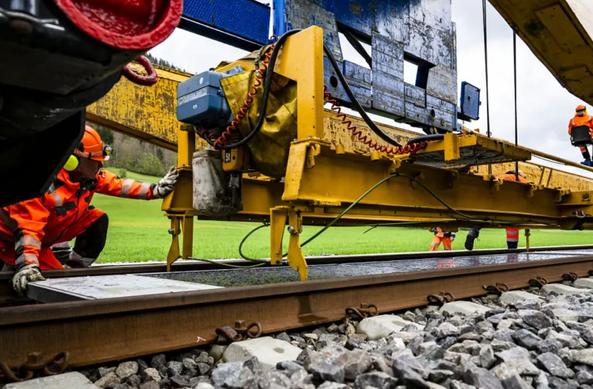
Die Schweiz weiht das erste Projekt zur Solarstromerzeugung zwischen Bahnschienen ein - Solarchitecture
Am 24. April 2025 hat Sun-Ways das weltweit erste für den Bahnverkehr freigegebene zwischen Bahnschienen verlegte Photovoltaik-Kraftwerk eingeweiht. Bei eher trübem Wetter hat Sun-Ways seine erste Solaranlage in den Neuenburger Bergen
What reasons wouldthat be?
The reason they're doing it is because Switzerland has >5000km rails. And since Switzerland is not very big, they intend to use every dead space they can. That's why they're doing a field test, see how it goes. And it's not that you could use the space for anything else.
Roads are not a great place for solar.
A) get shades by cars.
B) get dirty
C) don't last
D) slippery to drive on.
Between rail lines also not a great idea.
A) get shades by trains.
B) get dirty, from train brake dust. Have a look under a train, it gets covered in dust.
C) need custom size panels, custom fixtures.
D) needs to be moved to check and maintain sleepers, ballast, tracks.
E) impact damage
D) comes loose or tampered with and can cause serious derailment
F) needs special cleaning train.
G)low energy density.
In both cases building a standard frame on the side of the road/ rail corridor, or building on station roofs, or on the many empty roofs would be a lot cheaper and generate more electricity.
But these practical but boring things dont, don't get your company PR/clicks
@stux Why not both? Fields that can't be used for argiculture and car parks.
@stux There's some rudimentary info here on why it's actually a good idea: https://science.howstuffworks.com/environmental/green-science/agrivoltaics-solar-panels-agriculture.htm
Also, we can have solar panels on BOTH fields and car parks!
@stux Both is better!
But I understand that here in Louisiana, it's impossible. You see, if we covered our car parks then the cars we're forced to use wouldn't get steaming hot under the summer sun.
Sorry, it's very important that we make everyone extremely miserable for no reason. It's extremely important that we don't provide any shade to parked cars here in hot miserable Louisiana.
We also got rid of window awnings. That was very important also.
@stux cover *everything*
As panels are getting cheap, the support structure becomes a serious part of the cost (and even of the embedded energy). You need a lot more steel and foundations for such elevated panels.
Not sure about now, but not too long ago parking lots were money-losing PR projects(look us being green), while the field ones were serious.
Once we have enough PV to saturate summer peaks, every next panel produces less useful power. So lower cost is critical
@stux
I am seriously worried that we will kill off large-scale PV in the same way that we have now almost killed land-based wind. Keep adding well-intentioned restrictions until nothing gets built anymore
I am seriously worried that we will kill off large-scale PV in the same way that we have now almost killed land-based wind. Keep adding well-intentioned restrictions until nothing gets built anymore
